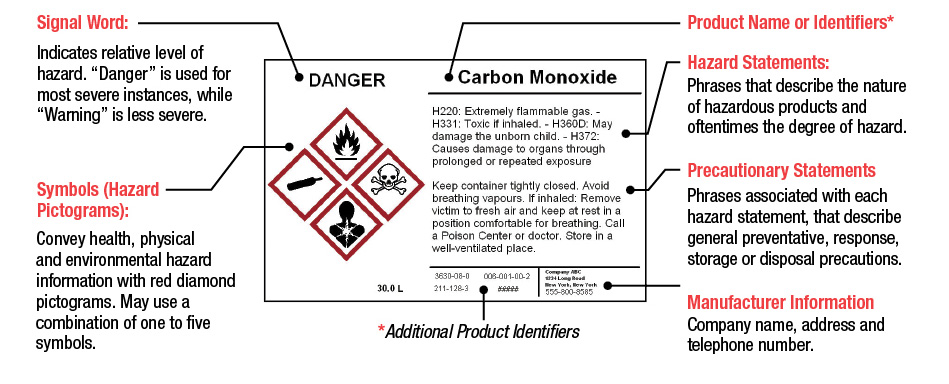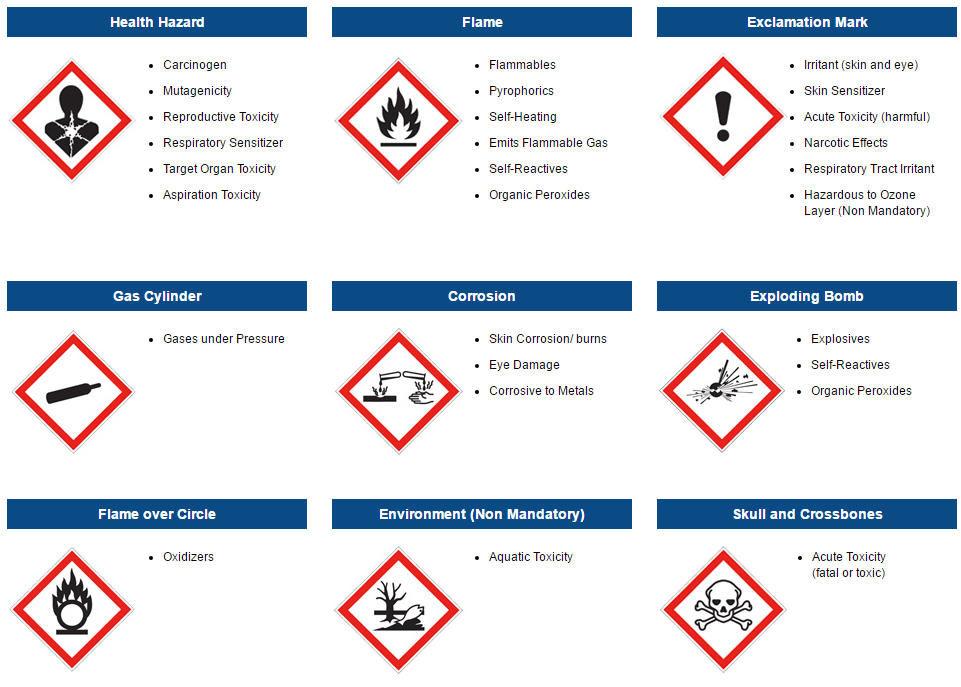These digital resources are also available for GHS Signs, Labels and Pictograms:
Overview GHS Guides & Scenarios GHS Digital Catalog GHS How-To Videos
What are the major changes with GHS?
There are three main areas in the existing HCS which have changed with the adoption of GHS: hazard classification, labels, and safety data sheets.
Hazard classification (formerly hazard determination) is one of the major areas of change. Definitions of hazard now provide specific criteria for classification of health, physical, and environmental chemical hazards along with the classification of mixtures. The current Hazard Communication Standard (HCS) provides parameters for evaluation, but doesn’t give specific, detailed criteria. The revised HCS, on the other hand, has specific criteria for each health and physical hazard, plus detailed instructions for evaluation. This new method of evaluation is covered in the required GHS training. The revised HCS also establishes hazard classes and categories. A class describes the different hazards. For example, “Gases under Pressure” is an example of a class in the physical hazards group. Categories are used to describe the sub-sections of classes. For example, “Self-Reactive Chemicals” has seven categories. Each category has rules or criteria to determine which chemicals are assigned to that category.
Standardized labels for hazard classes and categories will now be required. Previously, label preparation could be done in a variety of ways with the method being left to the preparer. Under the revised HCS, once classification has been done, the standard will specify what should go on the label. According to the revised HCS, labels will now require the following:
- A pictogram, which is the GHS symbol on the label and SDS (there are nine.) Not all categories will have an associated symbol.
- A signal word, which indicates the relative severity of the hazard. There are only two: danger (more severe hazards) and warning (less severe.)
- A hazard statement, which is a description of the nature of the hazards of the chemical. There is a hazard statement for each category of a class. For example, for chemicals in the “Self-heating substances and mixtures” class (category 1), the hazard statement would be “Self-heating; may catch fire.” This would appear on both the label and the SDS.
- A precautionary statement describing recommended measures to minimize or prevent adverse effects resulting from exposure to, improper storage of, or handling of a hazardous chemical.
Ready to get GHS compliant?
A Standard GHS Label Format

There are nine pictograms used in GHS to convey health, physical, and environmental hazards. The revised Hazard Communication Standard (HCS) requires the use of eight of them, with the exception being the environmental pictogram.
Can I change pictogram borders?
According to the revised HCS, all pictograms must have red borders. The purpose of keeping the color consistent is to increase recognition and make them easily comprehensible. Although some businesses might prefer to use a black border for domestic shipping, red is required for both domestic and international shipping. In addition, all red borders printed on a label must have a symbol printed inside. This is meant to limit confusion from workers who might be faced with blank labels. So, for maximum recognition and impact of warning labels, and to ensure that users don’t get desensitized to these warnings, a symbol must always be used with the red border.
What about updates?
With the revised Hazard Communication Standard (HCS), it’s now okay to update labels when new information on hazards becomes available. In fact, chemical manufacturers, importers, distributors, or employers who become “newly aware” of any significant information on the hazards of a chemical need to revise the labels within six months. Labels on any containers shipped after that time must have labels with the new information.
To Learn More About Seton’s GHS Signs, Labels and Pictograms:
GHS Signs, Labels and Pictograms HomeLaws, Regulations & Standards
How To Videos
GHS Guides & Scenarios
GHS Digital Catalog

